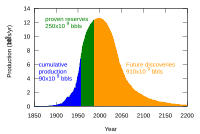
Photo from wikipedia
Abstract Oil sands mature fine tailings are stable suspensions of clay particles and residual bitumen in an alkaline aqueous medium. They are formed when bitumen is extracted from oil sands… Click to show full abstract
Abstract Oil sands mature fine tailings are stable suspensions of clay particles and residual bitumen in an alkaline aqueous medium. They are formed when bitumen is extracted from oil sands using the Clark hot water process. Polymer flocculants are widely used to flocculate and subsequently dewater these tailings, but our knowledge is limited to empirical observations on how they work. A fundamental mathematical model would help monitor and design flocculation and dewatering processes more efficiently. In this study, we used a population balance model to describe the flocculation of mature fine tailings (MFT) with poly(vinylbenzyl trimethylammonium chloride). A time varying function was defined to account for the aggregate size evolution during MFT flocculation induced by polymer chains relaxation and rearrangement on the particle surfaces. The validity of the model was tested by varying the shear rate, mixing time and flocculant dosage using focused beam reflectance measurements (FBRM). The proposed model is a first step towards a more rational and quantitative approach to monitor and control treatment processes for oil sands tailings.
Journal Title: Chemical Engineering Journal
Year Published: 2018
Link to full text (if available)
Share on Social Media: Sign Up to like & get
recommendations!